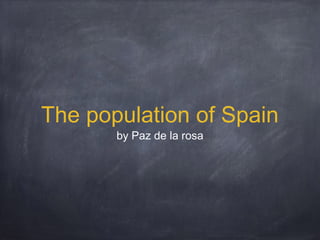
Population of spain
- 1. The population of Spain by Paz de la rosa
- 2. THE SPANISH POPULATION Spain has almost 50 million inhabitants in 2013, much more than in the past.
- 3. There are 2 reasons for this increase: - The birth rate is higher than the death rate --> positive natural increase. - Many immigrants have come to Spain to work or retired
- 4. Population structure There are more women than men Most inhabitants are between 16 and 65 years old. The Spanish population is agein. People are living longer and the birth rate is decreasing.
- 5. POPULATION DENSITY The most populated areas are the Autonomous communities on the coast, and the Autonomous Community of Madrid. The less populated area is the center of Spain. Most inhabitants live in provincial capitals and the main industrial and tourist centres.
- 6. The Economy
- 7. The active population The active population of Spain is aproximately 23 million people. About 26% of this population, 6 million people, is unemployed.
- 8. Economy sectors The primary sector The secondary sector The tertiary sector
- 9. Primary sector Only 5% of the active population work in the primary sector. It consists of the following activities: - Agriculture - Livestock farming - Fishing - Mining
- 10. The secondary sector The 26% of the active population work in the secondary section. It consists of: - Manufacturing: automobile, chemical, telecomunications, textile and food. - Construction: buildings, highways, railways and homes.
- 11. The tertiary sector About 69% of the active population work in the service (or tertiary) sector: tourism, trade, transport, education, healthcare...
- 13. Spanish borders - France, Andorra and the Bay of Biscay in the north - The Mediterranean sea and the Atlantic Ocean in the south - The Mediterranean Sea in the east - Portugal and the atlantic Ocean in the west
- 14. The Autonomous communities In 1978, Spain was divided into 17 Autonomous Communities and 2 Autonomous Cities, Ceuta and Melilla. Autonomous communities consist of one or more provincies. Each province is divided into municipalities
- 15. Spanish territory It includes most of the Iberian Peninsula, the Balearic island, the Canary island and the cities of Ceuta and Melilla in North Africa
- 17. The Constitution The Constitution establishes the form of government and it defines the rights and duties of citizens. All laws must follow the Constitution.
- 18. A Constitutional monarchy Spain is a constitutional monarchy. The monarch, Juan Carlos I, is the Head of State, but cannot make political decisions. The Spanish monarchy is hereditary: it is transmited from parents to child
- 19. Parliament Las Cortes is the name of the Spanish parliament. It creates and approves laws and controls government actions. The members of parliament are elected in general elections, every 4 years.
- 20. The government The government consist of: - The president - The ministers